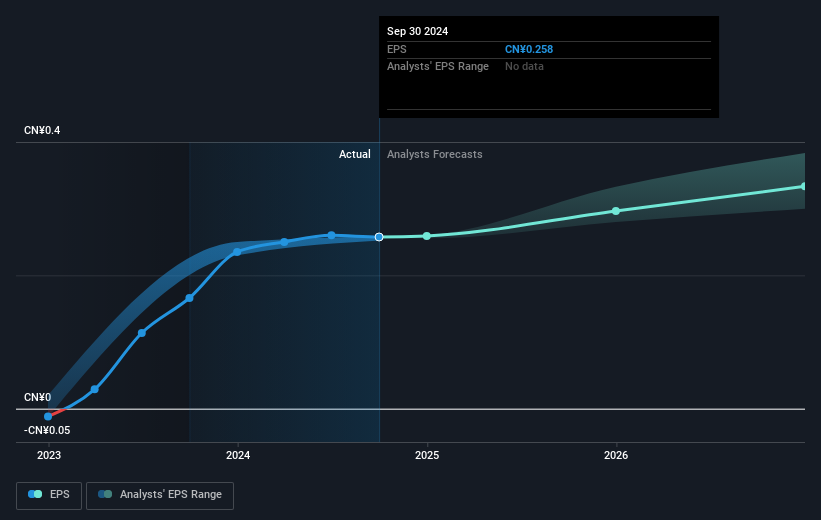- China
- /
- Transportation
- /
- SHSE:601816
Earnings grew faster than the 25% return delivered to Beijing-Shanghai High-Speed Railway (SHSE:601816) shareholders over the last year
These days it's easy to simply buy an index fund, and your returns should (roughly) match the market. But you can significantly boost your returns by picking above-average stocks. For example, the Beijing-Shanghai High-Speed Railway Co., Ltd. (SHSE:601816) share price is up 22% in the last 1 year, clearly besting the market return of around 6.9% (not including dividends). If it can keep that out-performance up over the long term, investors will do very well! However, the stock hasn't done so well in the longer term, with the stock only up 17% in three years.
In light of the stock dropping 4.1% in the past week, we want to investigate the longer term story, and see if fundamentals have been the driver of the company's positive one-year return.
See our latest analysis for Beijing-Shanghai High-Speed Railway
In his essay The Superinvestors of Graham-and-Doddsville Warren Buffett described how share prices do not always rationally reflect the value of a business. By comparing earnings per share (EPS) and share price changes over time, we can get a feel for how investor attitudes to a company have morphed over time.
Beijing-Shanghai High-Speed Railway was able to grow EPS by 55% in the last twelve months. It's fair to say that the share price gain of 22% did not keep pace with the EPS growth. So it seems like the market has cooled on Beijing-Shanghai High-Speed Railway, despite the growth. Interesting.
The image below shows how EPS has tracked over time (if you click on the image you can see greater detail).

It is of course excellent to see how Beijing-Shanghai High-Speed Railway has grown profits over the years, but the future is more important for shareholders. Take a more thorough look at Beijing-Shanghai High-Speed Railway's financial health with this free report on its balance sheet.
What About Dividends?
As well as measuring the share price return, investors should also consider the total shareholder return (TSR). The TSR is a return calculation that accounts for the value of cash dividends (assuming that any dividend received was reinvested) and the calculated value of any discounted capital raisings and spin-offs. It's fair to say that the TSR gives a more complete picture for stocks that pay a dividend. We note that for Beijing-Shanghai High-Speed Railway the TSR over the last 1 year was 25%, which is better than the share price return mentioned above. This is largely a result of its dividend payments!
A Different Perspective
It's nice to see that Beijing-Shanghai High-Speed Railway shareholders have received a total shareholder return of 25% over the last year. That's including the dividend. Notably the five-year annualised TSR loss of 2% per year compares very unfavourably with the recent share price performance. This makes us a little wary, but the business might have turned around its fortunes. I find it very interesting to look at share price over the long term as a proxy for business performance. But to truly gain insight, we need to consider other information, too. For example, we've discovered 1 warning sign for Beijing-Shanghai High-Speed Railway that you should be aware of before investing here.
If you are like me, then you will not want to miss this free list of undervalued small caps that insiders are buying.
Please note, the market returns quoted in this article reflect the market weighted average returns of stocks that currently trade on Chinese exchanges.
Valuation is complex, but we're here to simplify it.
Discover if Beijing-Shanghai High-Speed Railway might be undervalued or overvalued with our detailed analysis, featuring fair value estimates, potential risks, dividends, insider trades, and its financial condition.
Access Free AnalysisHave feedback on this article? Concerned about the content? Get in touch with us directly. Alternatively, email editorial-team (at) simplywallst.com.
This article by Simply Wall St is general in nature. We provide commentary based on historical data and analyst forecasts only using an unbiased methodology and our articles are not intended to be financial advice. It does not constitute a recommendation to buy or sell any stock, and does not take account of your objectives, or your financial situation. We aim to bring you long-term focused analysis driven by fundamental data. Note that our analysis may not factor in the latest price-sensitive company announcements or qualitative material. Simply Wall St has no position in any stocks mentioned.
About SHSE:601816
Beijing-Shanghai High-Speed Railway
Beijing-Shanghai High-Speed Railway Co., Ltd.
Undervalued with excellent balance sheet and pays a dividend.
Market Insights
Community Narratives




